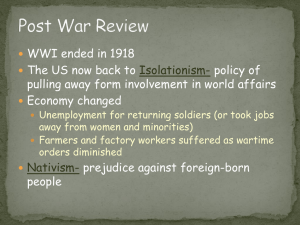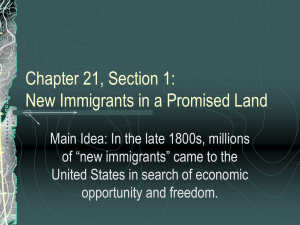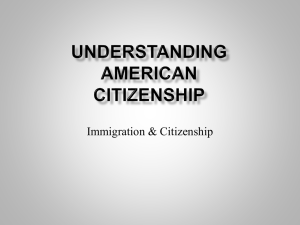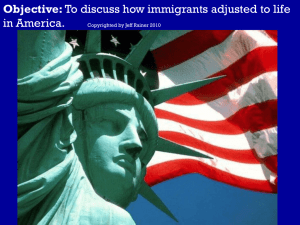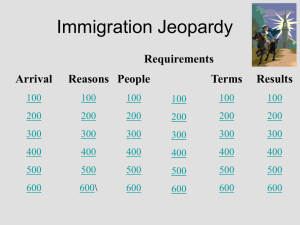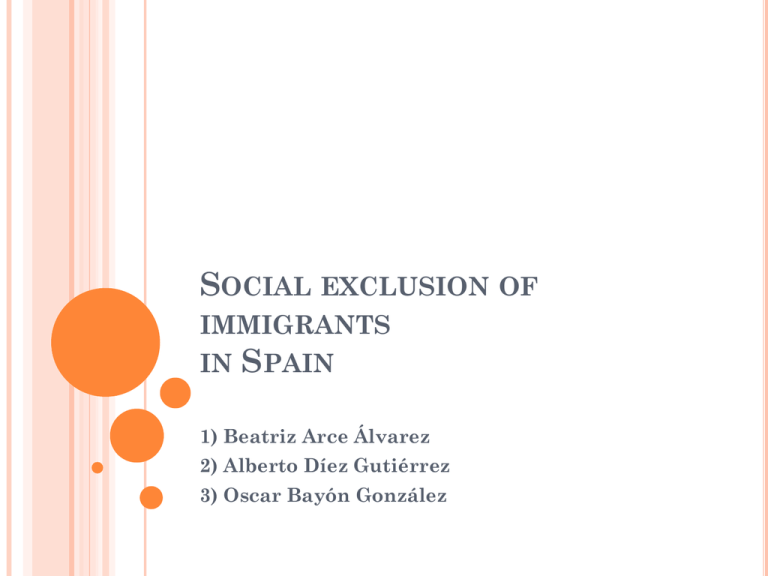
SOCIAL EXCLUSION OF
IMMIGRANTS
IN SPAIN
1) Beatriz Arce Álvarez
2) Alberto Díez Gutiérrez
3) Oscar Bayón González
INTRODUCTION
In Spain the immigration situation has evolved.
It can be said that without major tensions have
grown from an initial objective of arrival to
another of stay. In 2007, 81% of foreign
immigrants were raised to follow in our country
(INE 2007). The onset of the crisis has changed
the landscape by placing immigrants as a very
vulnerable socially. As can be seen,
unemployment rate affects differently: 12.56% to
21.26% of Spanish for foreigners. This puts
things more difficult for effective integration
policies, immediate consequences and the
difficulties for the renewal of licenses, or
unaffordable mortgages are obvious to outsiders.
HOUSING
The legal status and job insecurity of immigrants
determines their hous state. These economic
conditions leads to economic inability to access
housing property during the early years of stay in
the city, furthermore, reducing housing rented,
the increase in price and the prejudices of some
owners mean the creation of a kind of ghettos in
some urban areas.
In 2008, while 84.8% of Spanish households have
a home ownership, the percentage drops to 49.7%
in the case of families in the EU and 26.8% of
families around the world, a percentage has
fallen almost two percentage points over 2008.
JOB MARKET
Labor conditions are the main factor of
integration or exclusion for immigrants since
remuneration determines their feeding
conditions, their family support and their access
to housing. The double fragmentation of the labor
market, by sector and sex appears clearly defined
as: while the weight percentage of males from
foreign origin within the sectors of agriculture
(14%) and construction (27%) is higher than the
Spanish (7 and 17% respectively), immigrant
women devote their efforts to the service sector.
STRUCTURE OF IMMIGRANTS IN SPAIN
DISTRIBUTION OF IMMIGRANTS BY
SPANISH REGIONS
IMMIGRATION FORECASTS
According to National Institute of statistics
(INE), immigration flow will be reduced in the
coming years, from high of 958.000 immigrants
per year recorded in 2007 to 345,000 in 2012.
From 2012, the migratory flow is stabilized to
remain fairly constant, reaching a fixed
projection horizon of 400.000 immigrants in 2018,
providing a stable development of the annual
flow of input from people from abroad to that
year.
GOVERNMENTAL ROLE
The authorities will promote the full integration
for the foreigners into the Spanish society, in a
cohabitation setting of diverse identities and
cultures without any limits but the respect for
the Spanish Constitution and laws.
The Civil Service will add the aim for the
integration between immigrants, encouraging
their economic, social, cultural and political
participation, within the anticipated terms in the
Constitution, in the Statutes of Autonomy and in
the other laws.
CRUZ ROJA
Cruz Roja is an organization which works to be
more and more near people in the national and
international areas through actions of preventive,
welfare, rehabilitation and development nature,
being carried out mainly by voluntary work.
Nowadays, Cruz Roja is an organization made up
by volunteers which is present in more than 180
countries under the Red Cross and the Red Half
Moon sign and which has more than 100 million
volunteers who work over the world mobilizing
the "Humanity Power" in order to create a safer,
fairer and more egalitarian world.
CRUZ ROJA - PRINCIPLES
Humanity
Impartiality
Neutrality
Independence
Voluntary work
Unity
Universal principles
ATIME
ATIME must be understood as an "immigrants’
association" which could be named as "solidarity
with immigrants" association. ATIME is born
with a service vocation, in order to take care and
cover the requests from an incipient and more
and more numerous immigrant group in Spain,
but also with a clear protest vocation in whose
heart is the main idea of creating a fairer society
in which the immigrant was fully considered as
another more citizen, with rights but also with
duties.


